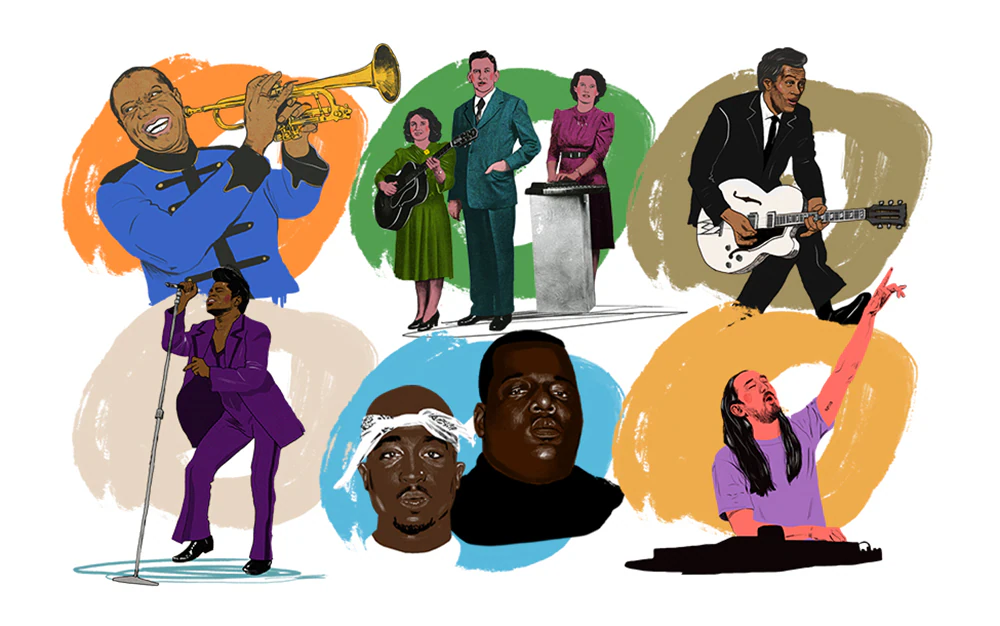The Evolution of American Music
The Evolution of American Music, American music is a vibrant tapestry woven from the threads of diverse cultural, social, and historical influences. From the spirituals sung by enslaved African Americans to the global phenomenon of hip-hop, American music has continually evolved, reflecting the changing landscape of the nation. This article explores the rich history of American music, tracing its development from the early colonial period to the present day.
Table of Contents
Early Beginnings: Colonial and Native Influences
The roots of American music stretch back to the early days of the colonies when European settlers brought with them traditional folk songs, hymns, and classical compositions. These sounds blended with the rich musical traditions of Native American tribes, whose songs and rhythms were integral to their cultural and spiritual practices. This early period laid the groundwork for a uniquely American musical identity, characterized by a fusion of different sounds and styles.
The Birth of Spirituals and the Blues
The introduction of African slaves in the 17th century had a profound impact on American music. Enslaved Africans brought their musical traditions, which included complex rhythms, call-and-response patterns, and improvisational techniques. These elements merged with European musical forms to create spirituals, a genre that expressed the deep religious faith and longing for freedom among the enslaved population.
In the post-Civil War era, the African American experience gave rise to the blues. Originating in the Mississippi Delta, the blues was a raw and emotional expression of life’s hardships and joys. Early blues musicians like Robert Johnson and Bessie Smith laid the foundation for a genre that would influence countless others, including jazz, rock, and R&B.
The Jazz Age: A Revolutionary Sound
The early 20th century saw the emergence of jazz, a genre that epitomized the spirit of innovation and improvisation. Jazz developed in the multicultural melting pot of New Orleans, drawing on African, Caribbean, and European musical traditions. Pioneers like Louis Armstrong, Duke Ellington, and Jelly Roll Morton pushed the boundaries of music, creating intricate melodies and harmonies that captivated audiences worldwide.
Jazz became the soundtrack of the Roaring Twenties, a decade marked by economic prosperity and cultural change. The genre’s popularity spread rapidly, influencing other music forms and giving rise to subgenres such as swing and bebop. Jazz’s emphasis on individual expression and improvisation set the stage for future musical revolutions.
Also Read: The Civil Rights Movement America
The Rise of Country and Folk
While jazz was taking the urban centers by storm, country music was developing in the rural South. Rooted in folk traditions brought over by European immigrants, country music told stories of everyday life, love, and hardship. The Carter Family and Jimmie Rodgers were among the early stars who shaped the sound of country music, blending elements of folk, blues, and gospel.
The 1930s and 1940s saw the folk revival, led by artists like Woody Guthrie and Pete Seeger. Their songs addressed social and political issues, using music as a tool for change and solidarity. Folk music’s emphasis on storytelling and acoustic instrumentation laid the groundwork for the protest songs of the 1960s.
The Rock ‘n’ Roll Revolution
The 1950s ushered in a new era with the advent of rock ‘n’ roll. This genre, characterized by a driving beat, electric guitars, and rebellious lyrics, was born from the fusion of rhythm and blues, country, and gospel. Chuck Berry, Little Richard, and Elvis Presley were among the trailblazers who brought rock ‘n’ roll to the forefront of American culture.
Rock ‘n’ roll’s influence was far-reaching, sparking the British Invasion of the 1960s and giving rise to numerous subgenres like surf rock, psychedelic rock, and heavy metal. The 1960s and 1970s were a golden age for rock music, with bands like The Beatles, The Rolling Stones, Led Zeppelin, and The Who achieving worldwide fame.

The Emergence of Hip-Hop and Electronic Music
The late 20th century saw the rise of hip-hop, a genre that began in the Bronx, New York, in the 1970s. Hip-hop culture, which includes rapping, DJing, graffiti, and breakdancing, emerged as a voice for marginalized urban youth. Artists like Grandmaster Flash, Run-D.M.C., and Public Enemy used their music to address social and political issues, blending rhythm and poetry in innovative ways.
Simultaneously, electronic music was gaining popularity. Pioneered by artists like Kraftwerk and Giorgio Moroder, electronic music utilized synthesizers and drum machines to create new sounds. The 1980s and 1990s saw the rise of various electronic genres, including techno, house, and trance, with artists like Daft Punk and The Chemical Brothers leading the charge.
The Modern Era: A Melting Pot of Genres
Today’s American music scene is a reflection of the country’s diverse cultural landscape. Genres continue to blend and evolve, creating new sounds and styles. Pop music, with its catchy melodies and broad appeal, remains a dominant force, with artists like Beyoncé, Taylor Swift, and Justin Timberlake topping the charts.
Hip-hop has grown into a global phenomenon, with artists like Kendrick Lamar, Drake, and Cardi B achieving immense success. The genre continues to push boundaries, incorporating elements from electronic, rock, and pop music.
Indie and alternative music have also flourished, offering a platform for artists who prioritize creative expression over commercial success. Bands like Arcade Fire, Vampire Weekend, and Tame Impala have carved out significant niches in the music industry.
The Digital Revolution
The advent of the internet and digital technology has transformed the music industry. Streaming services like Spotify and Apple Music have made it easier than ever for listeners to access a vast array of music from around the world. Social media platforms have given artists new ways to connect with fans and promote their work.
Moreover, digital technology has democratized music production. With affordable recording equipment and software, independent artists can create and distribute their music without the need for a major record label. This shift has led to an explosion of new talent and increased diversity in the music industry.
Conclusion.
The evolution of American music is a testament to the country’s dynamic cultural landscape. From the early days of spirituals and blues to the modern era of hip-hop and electronic music, American music has continually reinvented itself, drawing on a rich tapestry of influences. As technology continues to advance and new cultural movements emerge, American music will undoubtedly keep evolving, reflecting the ever-changing spirit of the nation.







